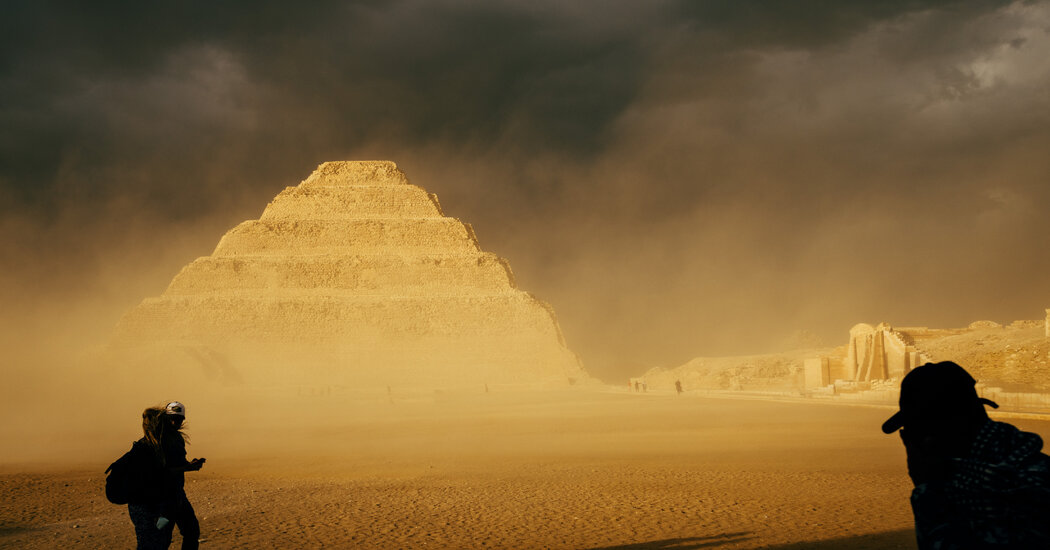
“Yallah, yallah, yallah! Woooo!”
I was visiting the pyramids of Giza, Egypt, in the company of Mark Lehner, a renowned Egyptologist, when suddenly a series of voices erupted and echoed throughout the site. Our small group turned to face the commotion, wondering what had happened — and if anything was wrong.
Instead, we saw the cheery faces of an approaching group of men running barefoot through the sand, some of them with bags and other equipment in tow. Their faces were sweaty under the sun, and their loads heavy, but their frequent whoops gave the scene a sense of celebration.
As it turns out, their jovial entry coincided with our own arrival at Dr. Lehner’s dig site, where the archaeologist and his team from the Ancient Egypt Research Associates, or A.E.R.A., are uncovering the Lost City of the Pyramids.
The energetic workers are led by Sayed Salah, whom they respectfully refer to as their “rais,” the Arabic word for “leader.” Their excavation work is grueling and laborious — but there’s a subtler, deeper level to it, as Dr. Lehner explained.
Many of the men, most of whom are from Abusir, a small town near Saqqara, see themselves as part of an esteemed team, one that links them all the way back to the Egyptians who had initially erected the pyramids.
Evidence uncovered in the last several decades suggests that the workers who built the great pyramids were not enslaved laborers, as has long been popularly believed. In fact, the work was likely done by paid laborers who were housed in nearby barracks. According to papyri fragments discovered by Pierre Tallet, an Egyptologist and the co-author (along with Dr. Lehner) of the book “The Red Sea Scrolls,” the work was considered a noble, respectable profession.
And the parallel between the high spirits of the workers of today and a new picture of those of the past was clear to see. In addition to the bonuses and celebration feasts that come along with this job, these men staunchly believed they were continuing the important work of their innovative predecessors.
I was in the presence of Dr. Lehner and his contemporary crew as part of a history-driven private tour of Giza’s pyramids, organized by the travel company Your Private Africa. On special occasions, Dr. Lehner partners with the group to lead historical journeys across Egypt for guests and patrons of his archaeological and research projects, a body of work that spans nearly 40 years.
My last visit to the pyramids was almost exactly 10 years ago, right before the Arab Spring revolution began. While Egypt has gone through a torrent of changes over the last decade, political and otherwise, these ancient wonders have remained as majestic and otherworldly as they ever were — though, as Dr. Lehner’s own work regularly demonstrates, there’s still plenty to learn about the structures and the people who made and used them. With his wide-ranging expertise, constant commentary and insider status (I lost track of the sheer number of government officials, other Egyptologists and guides who greeted him throughout the tour), my experience this time around, this past November, was undoubtedly richer.
Seeing the pyramids of Giza again — iconic monuments that thousands of visitors snap photos of every day — was a richer experience for me as a photographer, too. And that was largely because of one unexpected wild card: It rained.
In this part of the world, rainfall is a true rarity; the area generally sees less than an inch each year. And yet “bad” weather often allows for good photography. Streaks of light or interesting cloud cover can allow you to see things in a different way. That can be especially useful when trying to capture locations that are so heavily photographed.
So I considered it a stroke of luck when Mother Nature provided a rarefied dramatic backdrop just as we neared the Bent Pyramid in Dahshur, some 25 miles south of Cairo. This notable pyramid, I learned, is the second built by Sneferu, the founding pharaoh of the Fourth Dynasty of Egypt. (His successor, Khufu, went on to build Giza’s famous Great Pyramid.) Egyptologists now see the Bent Pyramid as a critical step toward the building of a strictly pyramidal tomb.
Mother Nature wasn’t finished with her show yet, either. A heavy dust storm swirled around the Step Pyramid of Djoser, part of the Saqqara necropolis that lies some 19 miles south of Cairo. Masks and scarves were whipped out as we arrived, with some people ducking away to shelter from the opaque wall of airborne sand.
The season of sandstorms, and the winds that cause them, are known as the khamsin, the Arabic word for “50,” referring to the 50 days of potential storms that arrive in late winter or early spring. From my perspective though, seeing Egypt’s most famous ancient treasures under such drama-filled circumstances only made these inimitable structures more otherworldly.
I continue to keep up with Dr. Lehner’s fascinating excavation work through regular dispatches that he sends out to his research supporters. He’s currently sifting through the sands of a Giza-based dig site called Heit el-Ghurab, a 4,500-year-old settlement that includes two different ancient towns, a delivery bay and several identifiable main streets. His daily considerations — which he jokes are all about testing “beautiful theories” against sometimes “ugly facts” — range from hypothesizing about the ability of cattle to fit through certain ancient openings to the exact usage of an area of the settlement he has called the OK Corral. (“OK,” in this case, cleverly stands for “Old Kingdom.”)
And so I eagerly await his findings. As I have directly observed, I know that the workers excavating the sites beside him will be there to joyfully cheer each new bit of information the team unearths.
Tanveer Badal is a travel, architectural and lifestyle photographer based in Los Angeles. You can follow his work on Instagram.




